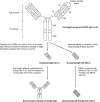Preclinical aspects of anti-VEGF agents for the treatment of wet AMD: ranibizumab and bevacizumab
- PMID: 21455242
- PMCID: PMC3178135
- DOI: 10.1038/eye.2011.66
Preclinical aspects of anti-VEGF agents for the treatment of wet AMD: ranibizumab and bevacizumab
Abstract
Three anti-vascular endothelial growth factor (VEGF) therapies are currently used for the treatment of patients with wet age-related macular degeneration (AMD): pegaptanib, ranibizumab, and bevacizumab. Ranibizumab is an antibody fragment approved for the treatment of wet AMD. Bevacizumab is a full-length antibody registered for use in oncology but unlicensed for wet AMD. However, it is used off-label worldwide not only for wet AMD but also for various other ocular diseases associated with macular edema and abnormal vessel growth. We consider aspects of ranibizumab and bevacizumab in relation to their molecular characteristics, in vitro and in vivo properties, and preclinical safety data. Before 2009, most studies described the short-term toxicity of bevacizumab in multiple cell types of the eye. Since 2009, an increasing number of studies have compared the properties of ranibizumab and bevacizumab and investigated their impact on retinal cell functioning. Compared with bevacizumab, ranibizumab neutralizes VEGF better at low concentrations, maintains efficacy for longer, and has a higher retinal penetration and potency. Studies in animals demonstrate ranibizumab to be better localized to the injected eye, whereas bevacizumab appears to have a greater effect in the fellow eye. In humans, a localized and systemic effect has been reported for both molecules. In conclusion, overlapping yet distinct pharmacological properties of ranibizumab and bevacizumab indicate that safety or efficacy data from one cannot be extrapolated to the other.
Figures
Comment in
-
Comment on 'Preclinical aspects of anti-VEGF agents for the treatment of wet AMD: ranibizumab and bevacizumab'.Eye (Lond). 2012 Jan;26(1):167; author reply 167-8; discussion 168. doi: 10.1038/eye.2011.193. Epub 2011 Nov 4. Eye (Lond). 2012. PMID: 22056862 Free PMC article. No abstract available.
Similar articles
-
Comment on 'Preclinical aspects of anti-VEGF agents for the treatment of wet AMD: ranibizumab and bevacizumab'.Eye (Lond). 2012 Jan;26(1):167; author reply 167-8; discussion 168. doi: 10.1038/eye.2011.193. Epub 2011 Nov 4. Eye (Lond). 2012. PMID: 22056862 Free PMC article. No abstract available.
-
Targeting vascular endothelial growth factor: a promising strategy for treating age-related macular degeneration.Drugs Aging. 2007;24(8):643-62. doi: 10.2165/00002512-200724080-00003. Drugs Aging. 2007. PMID: 17702534 Review.
-
Antivascular endothelial growth factors in age-related macular degeneration.Dev Ophthalmol. 2010;46:21-38. doi: 10.1159/000320007. Epub 2010 Aug 10. Dev Ophthalmol. 2010. PMID: 20703030
-
[VEGF in age-related macular degeneration. Part II. VEGF inhibitors use in age-related macular degeneration treatment].Klin Oczna. 2007;109(1-3):97-100. Klin Oczna. 2007. PMID: 17687925 Review. Polish.
-
Safety and efficacy of intravitreal anti-VEGF injections for age-related macular degeneration.Curr Opin Ophthalmol. 2009 May;20(3):223-5. doi: 10.1097/ICU.0b013e328329b656. Curr Opin Ophthalmol. 2009. PMID: 19367163 Review.
Cited by
-
[Atrophy of the macula in the context of its wet, age-related degeneration : An inescapable consequence of anti-VEGF therapy?].Ophthalmologe. 2016 Dec;113(12):1036-1045. doi: 10.1007/s00347-016-0306-9. Ophthalmologe. 2016. PMID: 27364637 Review. German.
-
TCCR/WSX-1 is a novel angiogenic factor in age-related macular degeneration.Mol Vis. 2012;18:234-40. Epub 2012 Jan 28. Mol Vis. 2012. PMID: 22312192 Free PMC article.
-
Transfer of single dose of intravitreal injection of ranibizumab and bevacizumab into milk of sheep.Int J Ophthalmol. 2017 Jul 18;10(7):1069-1075. doi: 10.18240/ijo.2017.07.08. eCollection 2017. Int J Ophthalmol. 2017. PMID: 28730108 Free PMC article.
-
A First-Passage Model of Intravitreal Drug Delivery and Residence Time-Influence of Ocular Geometry, Individual Variability, and Injection Location.Invest Ophthalmol Vis Sci. 2024 Oct 1;65(12):21. doi: 10.1167/iovs.65.12.21. Invest Ophthalmol Vis Sci. 2024. PMID: 39412819 Free PMC article.
-
Comment on 'Preclinical aspects of anti-VEGF agents for the treatment of wet AMD: ranibizumab and bevacizumab'.Eye (Lond). 2012 Jan;26(1):167; author reply 167-8; discussion 168. doi: 10.1038/eye.2011.193. Epub 2011 Nov 4. Eye (Lond). 2012. PMID: 22056862 Free PMC article. No abstract available.
References
-
- Jager RD, Mieler WF, Miller JW. Age-related macular degeneration. N Engl J Med. 2008;358:2606–2617. - PubMed
-
- Gragoudas ES, Adamis AP, Cunningham ET, Jr, Feinsod M, Guyer DR. Pegaptanib for neovascular age-related macular degeneration. N Engl J Med. 2004;351:2805–2816. - PubMed
-
- Rosenfeld PJ, Brown DM, Heier JS, Boyer DS, Kaiser PK, Chung CY, et al. Ranibizumab for neovascular age-related macular degeneration. N Engl J Med. 2006;355:1419–1431. - PubMed
Publication types
MeSH terms
Substances
LinkOut - more resources
Full Text Sources
Other Literature Sources
Medical


